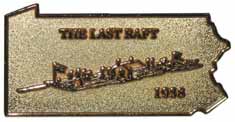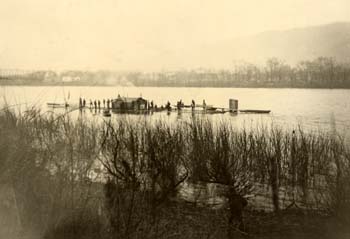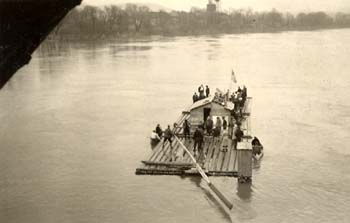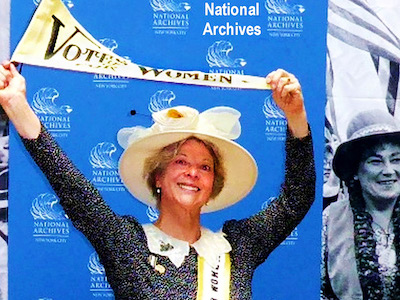The Last Raft project is a documentary about a March 20, 1938 tragedy when a lumber raft collided with a railroad bridge spanning the West Branch of the Susquehanna at Muncy. Of the 45 people who plunged into the icy river, all but seven were rescued. Although it took weeks of grappling the river and shores, all of the deceased eventually were recovered.
It’s not just a story about the crash. It’s the story about the journey. Many people don’t know that the Last Raft finished the journey.
 Last Raft Documentary DVDs
Last Raft Documentary DVDs
The Last Raft …
A Story of Courage and Tragedy on the Susquehanna
The Last Raft captures the glory and tragedy of the March 1938 journey using archival film footage, photos, eyewitness interviews, and new footage shot at the actual locations of the events. This one-hour documentary tells this story as never before, with a wealth of previously unshared material. $20/DVD
Produced by Karen L. Frock; Directed by JD DiAngelis; In conjunction with WVIA PBS Channel 44; Made possible in part by The Muncy Historical Society and Museum of History
 “Last Raft” casted lapel pins ($5).
“Last Raft” casted lapel pins ($5).
Sponsored by the Muncy Historical Society, the components of the project are eyewitness interviews, vintage photographs and film footage of the event and its aftermath. A documentary is an educational tool that will let viewers relive rafting days on the Susquehanna, as well as the horror of its most calamitous event.
Karen L. Frock of Creekside Creative Media is the researcher, writer, and producer of “The Last Raft” documentary.
The story of the Last Raft began with brothers R. Dudley Tonkin of Tyrone and V. Ord Tonkin of Cherry Tree. A lumbering family, the Tonkins came to the town of Cherry Tree 100 years before The Last Raft. Vince Tonkin, Dudley and Ord’s father, had left timber standing with the request that the two brothers occasionally cut the trees and build a raft to float as a living history lesson. The elderly Tonkin thought that the event would help to preserve the days gone by and he wanted to share that experience with new generations.
Piloted by Harry Conner of Burnside, a river raft pilot for 50 years, the 112-foot long timber raft was launched March 14, 1938, in Bell Township, Clearfield County, and was to end 200 miles away in Harrisburg.
The event garnered worldwide publicity as newspaper journalists, photographers, and radio and newsreel crews tagged along. The raft was seen by many thousands of Cambria, Indiana, Clearfield, Centre, Clinton, and Lycoming County residents as it floated the river, tying up at cities along the West Branch route.
School children – some of whom remain and remember the experience – lined up along the riverbanks, many waving American flags as the raft followed the current from Clearfield to Renovo, then to Lock Haven and Williamsport. There, Conner turned the piloting over to another person who was, the producer said, familiar with the lower river.
Barely hours after the raft “ran the chute” in Williamsport, it collided with the Reading Railroad Bridge in Muncy. Florence Leiby Smith, then a 22-year-old student at Bloomsburg Hospital School of Nursing home for the weekend, joined friends on the bridge to watch the raft. In a later interview, Leiby Smith said, “The bridge was filled with people and later newspaper accounts said there were hundreds, which is probably true. I had my box camera with me and took a picture of the raft as it approached the bridge, then walking to the other side we could see the raft was going to hit.”

People line up along a bridge to watch the Last Raft float down the West Branch of the Susquehanna River.
She took photos before, during and after, which have been included in several publications. Her memory of the event, along with many others, is part of the Last Raft documentary, which describes the heroic efforts of the people of Muncy to rescue the raftsmen.
The 38 people swept into the icy waters were saved by onlookers. The project team located several archival “Last Raft” films from 1938, three of which they have had transferred to digital video. One of those films is from the collection of the Thomas T. Taber Museum of the Lycoming County Historical Society, a film made by amateur filmmaker Charles Askey, of Williamsport. It includes a lengthy sequence shot in color, which the project team has had restored from faded blue to its original hues.
People may contribute directly to the Historical Society, P.O. Box 11, Muncy, PA 17756, or by calling 570-546-5917.
“Wherever there is lumber being harvest today, there is a story to be told. We honestly believe that the Last Raft story will be told in virtually every lumbering community in the United States and Canada. It’s a story of our heritage, but it has a wide range impact. It’s the story about what happened on the Susquehanna River. It’s the story about lumber heritage.”
William Poulton, President, Muncy Historical Society
Stories Within Stories
There are numerous stories within the larger story of The Last Raft’s journey.
In March 1938, the raft collided with the railroad bridge near Muncy. There were 45 or 48 people on the raft at the time it crashed; all but two were swept into the water. Hundreds of people on the bridge and shoreline watched in horror.
Sea Scouts and Boy Scouts who were passengers helped save lives, pulling some people back onto the raft, throwing firewood to others. Some spectators already out on the river in small boats moved to help passengers desperately trying to stay afloat in the icy water.
A 14-year-old boy on shore, Paul Fenstermacher, went right into the river and pulled at least one man to safety. His uncles ran for the wagon barn to get their boats into the water; his grandmother and aunts ran for the farmhouse, to put the hot water on. Soon people began bringing in survivors, nearly dead, full of water, chilled to the bone.
Besides Dudley and Ord Tonkin, the raft’s sponsors, Harry C. Conner, of Burnside, the pilot for the journey until Williamsport, was among those who perished, after taking the raft through the dangers of the upper river.
Dr. Charles F. Taylor, the Burgess of Montgomery who went to Lock Haven to ask the raft sponsors to stop in his town so that people could see the raft up close, perished. Taylor joined the trip in Williamsport but did not live to arrive in his Montgomery.
The others who died were Malcolm McFarland, Harold Beringer, W. Holley, W.C. VanScoyoc, and Thomas Proffitt, a Universal Newsreel cameraman who died in the line of duty while filming the journey. Proffitt literally went down cranking, filming up to and including the impact with the bridge. He was still shooting after he was in the water, looking up, before he and his camera disappeared. They recovered Proffitt’s camera from the river a few days later. Universal paid volunteers each $25, took the camera to a lab and dried out the film. The planned documentary contains the moment of impact frames, as well as magnificent archival footage It was nearly a month before Thomas Profitt, himself, was found.

After the initial impact with the fifth pier of the Reading Railroad Bridge, the current swung the Last Raft toward the right bank, and it “saddle bagged” against the sixth pier. All but one person were cast into the river.
Among those who survived was another medical professional, Dr. Dudley Turner, whose son, also a Williamsport osteopath, recounts his father’s ordeal for the documentary.
Helping to save lives were many people, including Frank Stevens, Boy Scout, who documented the journey in photos that will be used in the program; Ollie Helmrich, Sea Scout, of the Williamsport family that still operates Helmrich’s Sea Food; and Paul Fenstermacher, a 14-year-old boy who went right off the riverbank into the water and began to pull people to shore.
Volunteer firemen and others went out, day after day, dragging the river in boats, hanging hooks from bridges, and searching the numerous small islands that line the Susquehanna. It was a large professional search effort, too: including a Navy diver, Coast Guard boat, state police, and aircraft. Employers let their people out of work to search; kids cut school to watch. They even dynamited near the bridge, in hopes of freeing submerged bodies.
But the river gave up its dead on its own schedule. Harry Conner was found downriver, almost across from Montgomery Park, at around 6 on Easter Sunday morning. Soon after, the rest were recovered. Dr. Taylor was missing the longest: a full month. The Rotary in his town put up a $100 reward for his body.





